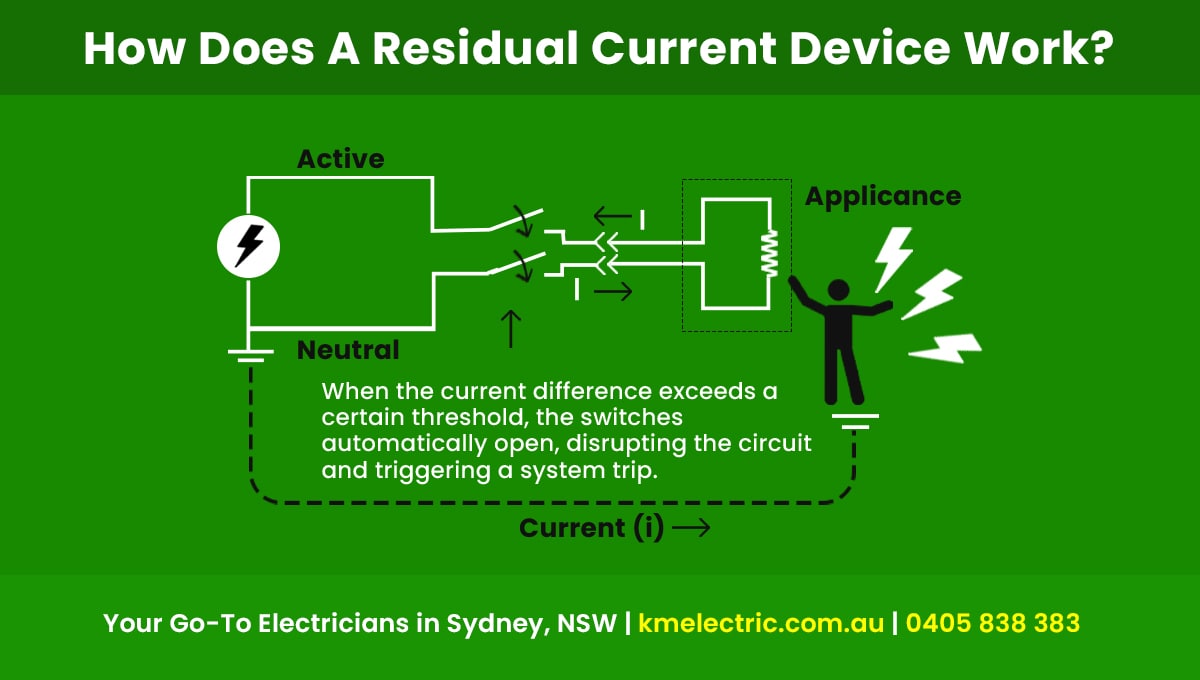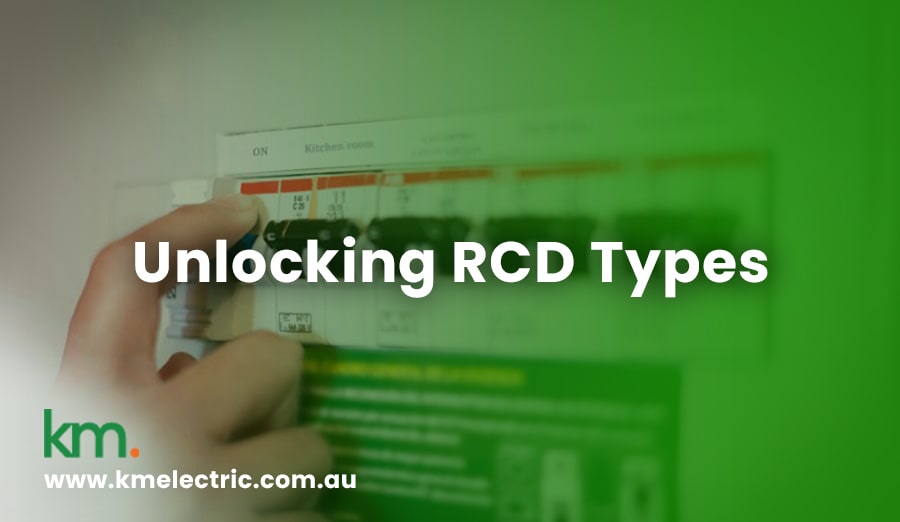Powerful electrical currents run through our homes and workplaces, unseen but essential. And if you’re someone interested in understanding how your electrical system works, you may have found yourself asking one time or another: What is an RCD? What does RCD stand for, or what is the meaning of RCD?
In terms of electrical safety, this unsung hero stands guard: the residual current device or RCD, which a lot of people seem to confuse with the safety switch. In fact, this confusion is so common some people even use the terms interchangeably. But more on this later.
This blog post delves into the critical role of RCDs, unravelling their significance in safeguarding lives and property. From preventing electric shocks to minimising the risk of fires, understanding the inner workings of these devices is paramount for both homeowners and businesses.
We’ll explore how residual current devices work, why they are indispensable in modern electrical systems, and the evolving standards shaping their implementation. Read on as we demystify the essential residual current device, ensuring your electrical infrastructure is not just powered but protected.
What Is an RCD?
If you’re one of those people who has always thought that RCDs and safety switches are one and the same, you must be wondering: What is a residual current device?
The RCD is a fundamental electrical safety device designed to prevent electric shocks and fires. Picture it as a watchful guard monitoring the flow of electricity constantly. Its primary function is to swiftly detect any imbalance between the live and neutral currents, indicating a potential leakage or fault in the electrical circuit.

Here’s the nitty-gritty: If someone accidentally touches a live wire or there’s a faulty appliance, the RCD springs into action. It senses the uneven current flow and within milliseconds, cuts off the power, preventing harm or damage. It works like a superhero for your electrical system, ensuring that any potential danger is neutralised before it can cause serious damage.
RCD vs Safety Switch: Why the Confusion?
In some places, safety switches are considered a specific type of RCD. Both RCDs and safety switches play pivotal roles in electrical safety, with RCD being a broader category encompassing various protective devices, including safety switches.
Knowing their similarities and differences may help clarify the distinction between the two terms:
Similarities:
- Safety Focus: Both safety switches and RCDs work to protect individuals and property from electrical hazards.
- Detection Mechanism: They operate by detecting imbalances in electrical currents, signalling potential faults or leakages.
Differences:
- Categories: The key distinction lies in their categories. An RCD is a broader term encompassing various devices that monitor and manage electrical currents. A safety switch is a specific type of RCD designed solely to prevent electric shock incidents.
- Function: While safety switches exclusively guard against electric shocks, RCDs cover a wider spectrum, also providing protection against fires caused by faulty appliances or wiring.
- Tripping Speed: Safety switches typically have faster tripping speeds, responding swiftly to potential electric shock situations. RCDs, as a broader category, may include devices with different tripping characteristics.
In Australia, the terms ‘RCD’ and ‘safety switch’ are frequently treated like synonyms. Sometimes you may also encounter the term RCD safety switch or switches. The confusion between the terms stems from their shared mission of enhancing electrical safety. Both are components crucial for preventing electric shocks and fires, leading to their interchangeable use in everyday language.
In a way, both statements are essentially correct, and the choice of terminology may depend on regional or industry-specific practices. The crucial aspect is recognising the function and purpose of these devices in electrical safety, whether referred to as safety switches or RCDs. They all work towards preventing electric shocks and enhancing overall safety in electrical systems.
RCD vs Circuit Breaker: What’s the Difference?
Now, let’s move on to the RCD vs circuit breaker comparison.
People also tend to confuse the RCD and circuit breaker, primarily because of their shared presence in electrical distribution systems and their roles in enhancing safety. It’s like mistaking two players on a sports team for having similar functions (i.e., to defend the team or lead the team to victory) – they’re both essential, but they play different positions.
A circuit breaker is the rapid-response system against excessive current flow. It’s the gatekeeper that swings into action when your electrical devices throw a wild party, drawing more power than they should. It detects abnormal current surges, then works by immediately cutting off the power supply to prevent potential damage. This happens faster than you can say ‘timeout’, protecting your appliances and wiring.
Circuit breakers focus on preserving the integrity of your electrical system by preventing overload-induced meltdowns or short circuits. They don’t have exactly the same goal as RCDs, which are more concerned with leakages and imbalances that can lead to shocks or fires.
To recap and better understand the differences, remember their:
Similarities:
Both RCDs and circuit breakers are vital components safeguarding electrical systems, and they share the common goal of preventing potential hazards. However, the source of the confusion lies in the differences in their functions and the specific types of threats they address.
Differences:
- Functionality: An RCD works against leakages and imbalances in electrical currents, designed to prevent electric shocks and fires. On the other hand, a circuit breaker interrupts the flow of electricity in case of overloads or short circuits, preventing damage to the electrical system.
- Triggering Mechanism: RCDs respond to imbalances between live and neutral currents, tripping almost instantly to cut off power. Circuit breakers, however, detect abnormal increases in current flow, acting swiftly to disrupt the circuit when needed.
Understanding the differences between a circuit breaker and RCD is like having a playbook for your electrical safety game – each player has a specific role, ensuring a coordinated defence against potential threats.
How Does an RCD Work?
So, you may ask, how does an RCD work, exactly?
An RCD constantly monitors the flow of current in a circuit. In an ideal, balanced scenario, where the current flowing into an appliance matches the current returning, the RCD is all cool and calm. However, in a scenario where someone is getting a shock or a leak happens – the RCD senses the difference between the incoming and outgoing currents, even if it’s a tiny mismatch.
When this happens – and we’re talking milliseconds here – the RCD springs into action, shutting off the power faster than you can blink. By cutting the power quickly, the RCD does two crucial things:
- It prevents electric shocks by stopping the flow almost instantly.
- It safeguards you and your property against potential fires caused by faulty gadgets or wiring.
Once the issue (e.g., faulty appliances, damaged cords, other potential electrical issues) is sorted out, resolved or removed, you just need to hit the reset button on the RCD (typically located in the consumer unit or distribution board), and you’re back in business. However, if you’re unsure about the cause of the trip or if the RCD continues to trip after resetting, it’s advisable to seek assistance from a qualified electrician to identify and resolve any underlying issues.
In a nutshell, the RCD is focused on keeping the current flow in check, instantly reacting to any hint of trouble to ensure you have a shock-free and fire-safe environment.

RCD Types Explained
There are different categories of RCDs and, subsequently, various RCD types.
The common types of RCDs based on their applications and functionalities in terms of electrical protection against different scenarios include:
Fixed-Residual Current Device (Fixed-RCD)
- Function: Installed in the distribution board, it monitors the entire electrical circuit for imbalances.
- Application: Offers broad protection for multiple circuits, ensuring comprehensive coverage for the entire electrical installation.
Socket-Outlet Residual Current Device (Socket-Outlet RCD)
- Function: Integrated into individual power sockets, providing localised protection for specific outlets.
- Application: Suitable for areas with a higher risk of electric shock, such as bathrooms and kitchens.
Portable Residual Current Device (Portable RCD)
- Function: Compact and portable, designed for temporary use with tools or appliances.
- Application: Ideal for construction sites or outdoor activities, providing on-the-go protection against electric shocks.
Time-Delay Residual Current Device (Time-Delay RCD)
- Function: Introduces a time delay before tripping, allowing for brief current surges without triggering unnecessary shutdowns.
- Application: Useful in situations where brief, intentional current surges occur, preventing unnecessary disruptions.
Switchboard-Mounted Residual Current Device (Switchboard-Mounted RCD)
- Function: Installed directly on the switchboard or distribution board.
- Application: Provides protection to the entire electrical installation, covering multiple circuits and outlets.
Each RCD type serves a specific purpose, offering tailored protection based on the requirements of the electrical system or the environment.
RCD Classifications Based on Their Response to Various Types of Currents
Now, there are also specific RCD types in a category focusing on the characteristics of the current they can detect and are primarily associated with differentiating the RCDs based on their response to various types of currents. They are specifically designed to ensure the safety of electrical systems by detecting and preventing imbalances in the current flow. These are:
Type A RCD
- Functionality: Type A RCDs provide protection against sinusoidal alternating currents and pulsating direct currents.
- Application: Suitable for general-purpose use in residential and commercial settings where a variety of loads is present.
Type B RCD
- Functionality: Type B RCDs offer protection against sinusoidal alternating currents, pulsating direct currents, and smooth direct currents. They provide enhanced protection compared to Type A or AC RCDs.
- Application: Suitable for environments with specific loads that may include electronic equipment, variable speed drives, or other devices generating smooth direct currents.
Type S RCD
- Functionality: Type S RCDs are specifically made to be used with electric vehicle (EV) charging equipment. They provide protection against sinusoidal alternating currents and pulsating direct currents.
- Application: Primarily used in EV charging installations and industrial types of systems.
Type F RED
- Functionality: Type F RCDs offer protection against sinusoidal alternating currents, pulsating direct currents, and smooth direct currents. They provide even broader coverage compared to Type B RCDs.
- Application: Suitable for environments with sensitive electronic equipment and loads generating smooth direct currents.
Installation and Maintenance
To ensure electrical safety, installing and maintaining RCDs is absolutely essential. Here are some important pointers in RCD installation and maintenance, covering key guidelines, optimal locations, wiring requirements, and the crucial aspects of testing and regular upkeep.
- Installation Guidelines: RCD installation should ideally be carried out by a qualified local electrician to ensure compliance with safety standards and regulations. They will help you choose the appropriate RCD rating based on the specific application and load requirements, and ensure proper connection to the circuit, with the RCD correctly placed in series with the conductors.
- Location: RCDs can provide protection to multiple circuits on circuit breakers or individual circuits through the use of Residual Current Breakers with Over-Current (RCBO). In the context of protecting multiple circuits, RCDs are integrated into the consumer unit (fusebox). Their strategic placement ensures comprehensive protection for various circuits. Additionally, RCDs are commonly positioned between circuit breakers and power sockets, enhancing their ability to detect and respond to faults efficiently. When it comes to individual circuit protection, the RCBO serves as a combined solution, integrating the functionalities of both the RCD and the Circuit Breaker. This allows for targeted protection of specific circuits, offering an added layer of safety. Typically, RCDs are installed on the supply side of the equipment they protect. This placement is often within a fuse box or on a distribution board, ensuring swift response to any irregularities in the electrical current. It’s worth mentioning that some electrical equipment may incorporate an RCD directly into the plug, providing localised protection for the connected device. This diverse application of RCDs and RCBOs is instrumental in maintaining electrical safety across various settings.
- Wiring Requirements: Ensure correct RCD wiring polarity during installation to guarantee the RCD functions as intended. Avoid combining RCD-protected and non-protected circuits on the same RCD to maintain effective protection.
- Testing and Regular Maintenance: Regularly test RCDs using the built-in ‘Test’ button to confirm proper functionality. This should be done at least every six months. If an RCD fails the test or is found to be faulty, replace it promptly to maintain reliable protection. Periodic professional inspections by qualified electricians are advisable to ensure the overall health and effectiveness of your RCDs. Remember, the proper installation and maintenance of RCDs not only done to adhere to safety regulations but also contribute significantly to the prevention of electrical hazards, safeguarding lives and property in the process.
How to Choose the Right Residual Current Device
Choosing the right RCD is a prerequisite for effective electrical safety. Key factors to consider include:
- Installation Type: Consider the installation environment, as different installation settings demand specific RCD types. For example, residential setups might benefit from Type A or AC RCDs, while electric vehicle (EV) charging stations require Type S RCDs.
- Sensitivity Requirements: The sensitivity of an RCD dictates the level of current imbalance that triggers it. For general applications, a 30mA sensitivity is common, providing a good balance between safety and avoiding nuisance tripping. In certain scenarios, a higher sensitivity may be required for enhanced protection.
- Load Characteristics: Identify the load characteristics. The nature of connected loads influences RCD selection. For environments with electronic equipment or variable speed drives, a Type B or F RCD may be suitable, offering protection against smooth direct currents.
- Regulatory Compliance: Ensure that the selected RCD complies with relevant safety standards and regulations in your state, area or region. In Australia, the AS/NZS 3760:2010 is the standard. providing guidelines and procedures for the routine testing of electrical equipment, including RCDs, to ensure their ongoing safety and reliability. You can also check our guide for more information on switchboard upgrade regulations in Australia.
When in doubt, consult with qualified electricians or professionals in the field. They can provide insights based on the specific characteristics of your electrical system and installation environment.
RCD Cost: What to Expect
The cost to install or replace an RCD in Australia can vary based on several factors. Here are some considerations that can influence the cost:
- Type of RCD
- Type of property (residential, commercial, industrial)
- Installation location
- Electrician’s charges
- Number of RCDs
- Quality of the RCD/s
- Additional materials needed (e.g., wiring, conduits, etc.)
As an RCD cost ballpark figure, a residential installation may cost anywhere between $250 and $300 plus GST.
Troubleshooting and Common Issues
Understanding common RCD issues and knowing when to consult professionals for troubleshooting is crucial to maintain electrical safety. Here are some common RCD issues:
- Frequent tripping
- Failure to trip during testing
- Incompatibility with certain appliances leading to nuisance tripping
- Ageing or outdated RCDs
- Incorrect wiring or installation
- External factors impacting RCD performance
When it comes to RCD issues and other problems (and even electrical switchboard upgrades) with your electrical system, it’s best not to try and troubleshoot them yourself, as the underlying cause also needs to be identified to arrive at an effective solution.
The expertise of licenced electricians is invaluable for maintaining a safe and reliable electrical system. Attempting DIY fixes without proper knowledge can pose risks. Always prioritise safety and consult professionals for any RCD-related problems.

Why Choose KM.Electric for RCD Installation
Do you need new RCDs or have faulty RCDs that need replacing?
KM.Electric is your reliable go-to for professional RCD installation and for addressing all kinds of electrical maintenance requirements and issues in Sydney.
We’re your 24-hour emergency electrician ready to help resolve problems with your electrical system wherever you are.
Get in touch today!









